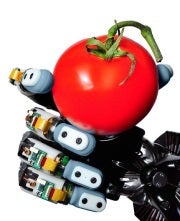
A robot hand equipped with SynTouch’s BioTac sensors. [Credit: USC Viterbi School of Engineering]We’ve seen more than a handful of research projects with the goal to make robots look and feelmore like us humans. A team of scientists from the University of Southern California’s Viterbi School of Engineering is aiming specifically to make just a single artificial finger sensor, called BioTac, that can detect textures even better than a human can.
BioTac is tactile sensor created by Biomedical Engineering Professor Gerald Loeb and recently graduated doctoral student Jeremy Fishel. The sensor is designed to mimic the human finger’s ability to feel motion, temperature, and even identify materials–like the difference between plastic and Gorilla Glass–by simply touching them. The technology could be implemented into robot hands or a new generation of artificial limbs.
BioTac does not only imitate a human’s ability to feel surfaces and materials, it’s also anatomically similar to a real human finger. The sensor’s outermost layer is made of a soft, flexible skin with its own fingerprints. There’s a liquid-filled layer under the skin followed by a hard, bone-like core.
 [Credit: Gerald Loeb and Jeremy Fishel]
[Credit: Gerald Loeb and Jeremy Fishel]
As the finger glides on a surface, the “skin” vibrates, and these vibrations get passed through the liquid layer to a hydrophone (underwater microphone). By looking at the waveform picked up by hydrophone, BioTac is able to judge the direction of its motion and able to identify materials based on its surface friction.
Fishel built the finger sensor into a specialized robot that can distinguish between 117 different materials, including stationery, fabric, and wood. When given a random material the robot could correctly identify the mystery surface 95 percent of the time.
The team further documented the BioTac research in a paper published by Frontiers in Neurorobotics. Loeb and Fishel are now partners in Syntouch LLC, a startup that makes tactile sensors for mechatronic systems. Meanwhile, BioTac sensors are currently being sold to other researchers and manufacturers of industrial robots and prosthetic hands.
[USC Viterbi School of Engineering, Frontiers in Neurorobotics via GizMag and The Verge]
